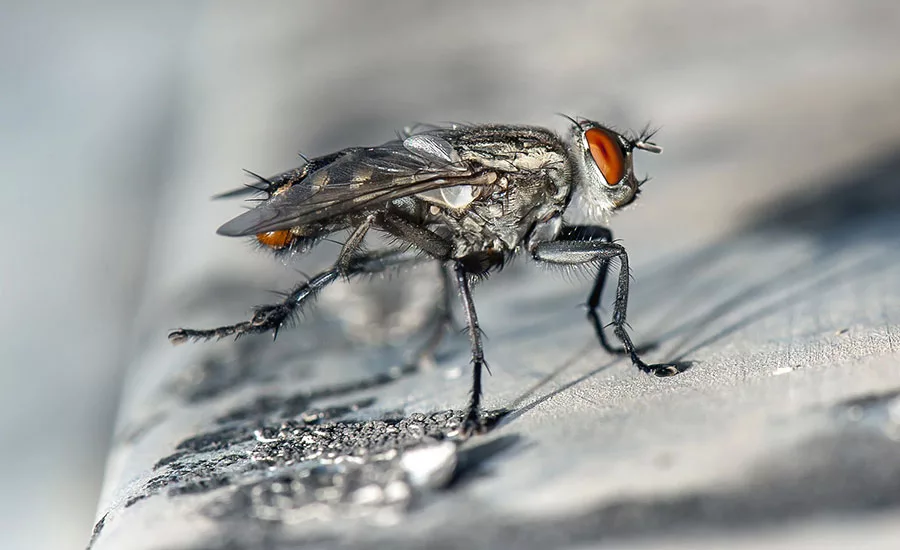Houseflies and Food Safety: What You Need to Know

The Dalai Lama said that “If you think you are too small to make a difference, try sleeping with a mosquito.” Insects in food facilities may be tiny, but they can make a big difference to your products. The housefly in particular may be relatively small, but it is certainly not harmless!
Between the feet, mouthparts, and hairs on the body, houseflies can pick up small particles of debris, food, and even dust. With that debris: pathogens. If you look closely at a housefly, you can see lots of hairs all over the body that particles can get stuck to. Looking at their feet and their mouthparts under magnification, you observe a large surface area. Ever heard that flies “taste” with their feet? Their feet have taste-sensing neurons to help them determine if something is food and if it is something they want to eat. While houseflies have a preference for sweets, they will feed on almost any number of liquid or semi-liquid food sources. The surfaces on their mouthparts and feet also pick up particles from the surfaces they land and feed on.
Houseflies have been known to transfer bacteria like Salmonella, Escherichia coli, and Campylobacter. They have also been implicated in spreading fungi like Aspergillus and parasites like Giardia and hookworms. Here is how that works: A fly lands on an infected surface (feet touch), likely gets a taste of that food source (mouthparts touch), then flies off—only to land on another food or surface in your processing area. Now that surface can become contaminated. One study looked specifically at E. coli and found “From the initial contamination levels of bacteria and the number of transferred bacteria, it can be calculated that flies contaminate clean surfaces with approximately 0.1 mg of food per landing.1
Watch a housefly for a while and you notice they are constantly cleaning themselves. They use their legs to groom themselves after eating. They will wipe down their entire head, mouthparts, sometimes even their wings and body. Then they rub their legs together and “shake off” the particles left. Those particles can be contaminated with any number of pathogens. Once again, those can end up on your raw ingredients, food contact surfaces, or finished products. Despite the personal grooming, houseflies aren’t all that clean. A study showed that E. coli “persisted on fly body surfaces up to 13 days after exposure” and actually suggested that the pathogen had time for growth while on the fly body.2
What goes in, must come out. With houseflies, it comes out both ends! Houseflies have a regurgitation behavior, most often to help soften up and liquefy the next food item they want to feast on. It has been shown that both the regurgitation and the defecation substances can contain pathogens.
Houseflies are pathogen-transferring machines. They start their lifecycle as eggs and larvae in decomposing, rotting material like trash, feces, and carrion. Adults emerge from this material, land on it to feed and lay more eggs, then fly off to find new food sources and egg-laying sites. That could be anywhere in your food facility. Not only are flies an indication of a sanitation issue, but they also carry and transfer bacteria such as E. coli, Salmonella, and more pathogens to the foods and food surfaces at your site. Managing housefly (and all pest issues) is important from a filth and a contamination standpoint. Don’t let those little flies make a big difference:
- Make sure preventative measures are in place like properly sealed doors, sanitation on the outside of the building, and regularly emptying dumpsters so they don’t overflow.
- Insect light traps should be installed at key points to intercept and monitor for incoming flies. When the numbers in the traps start to increase, start looking for conditions that are causing that increase.
- In the warmer months, targeted treatments on areas where flies may rest on the outside of the building can be helpful in reducing populations.
- Houseflies are typically breeding outdoors, but entering a site through doors and other openings. Finding and removing those outside sanitation issues (breeding sites) will have the greatest impact on reducing overall fly numbers.
Flies are small, but even a few individuals can make a big difference when it comes to food safety. Knowing that they can transmit pathogens and where they might be feeding and breeding can help manage these pests. Using integrated approaches that include sanitation, exclusion, and monitors can help keep flies at a minimum and prevent food safety issues.
References
- https://www.sciencedirect.com/science/article/abs/pii/S016816050300610X?via%3Dihub.
- https://apsjournals.apsnet.org/doi/pdfplus/10.1094/PHYTO-09-12-0217-FI.
Resources
1. For a review of the human pathogens carried by houseflies: https://link.springer.com/article/10.1186/s12889-018-5934-3.
Looking for quick answers on food safety topics?
Try Ask FSM, our new smart AI search tool.
Ask FSM →
2. Housefly eating: https://www.youtube.com/watch?v=N23E4jYTExk.
3. To watch a fly grooming (and look close about half way through, you can see particles coming off their legs!): https://www.youtube.com/watch?v=cIMTxIYWAjo.
Chelle Hartzer, M.Sc., BCE, is a consulting entomologist at 360 Pest and Food Safety Consulting and has been helping clients solve complicated pest issues for over a decade. Chelle holds an M.Sc. in entomology from Kansas State University and is a board-certified entomologist (BCE) in urban and structural entomology. She is also a Preventive Controls Qualified Individual and earned her Lean Six Sigma Green Belt.








